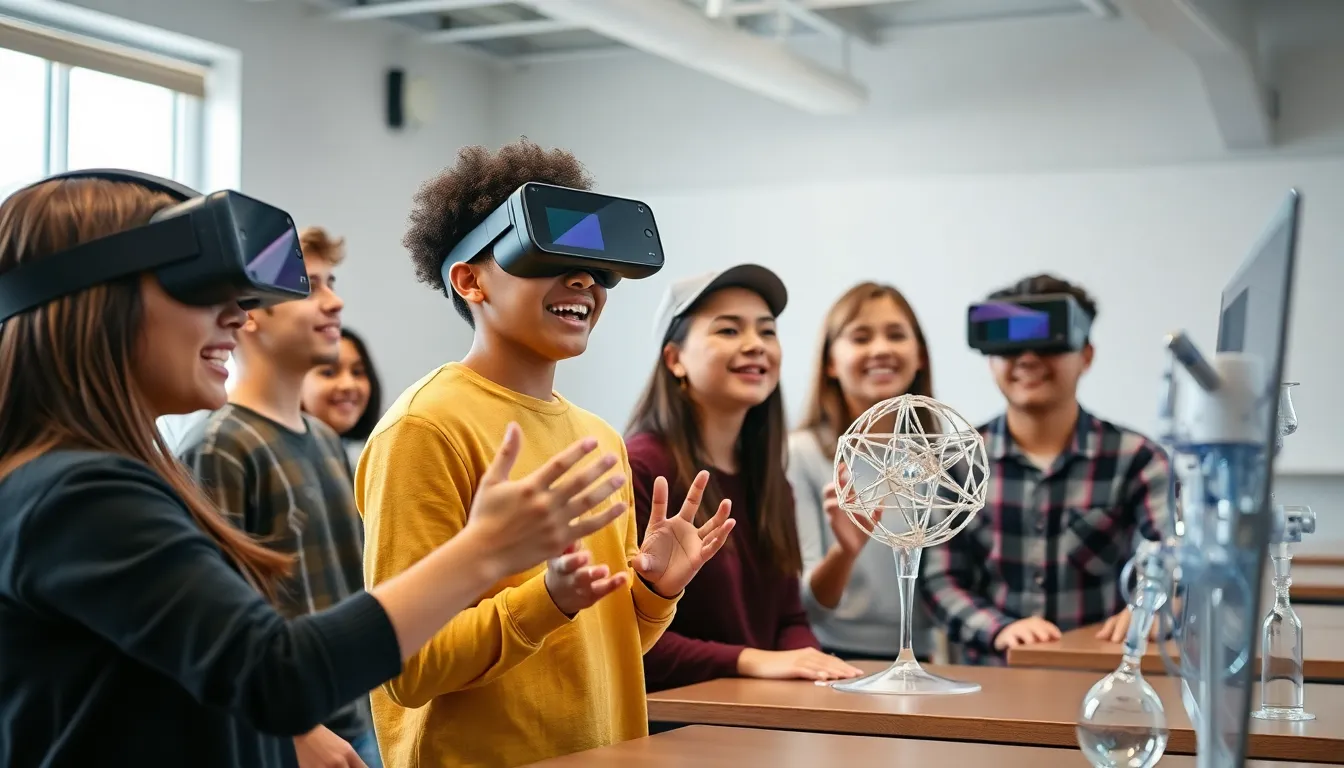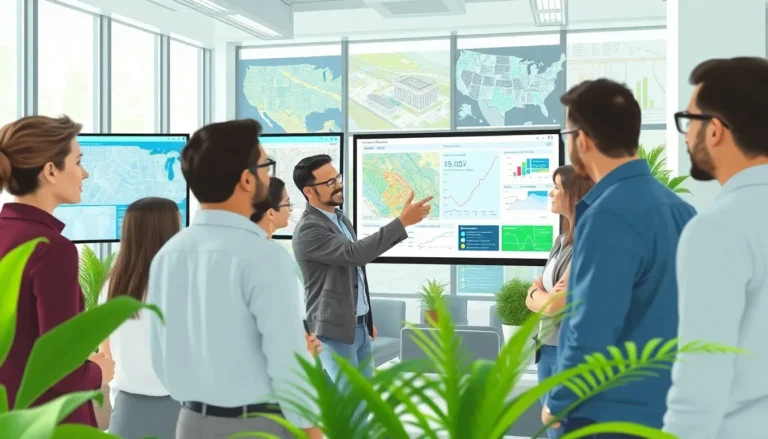Table of Contents
ToggleImagine walking into a classroom where history comes alive, and math problems leap off the page. With augmented reality (AR) in education, this isn’t just a dream—it’s a reality waiting to unfold. AR transforms traditional learning into an interactive adventure, making lessons more engaging and memorable.
Overview of AR for Education
Augmented reality transforms traditional learning environments by integrating digital content with real-world contexts. Educators increasingly use AR to engage students across various subjects, fostering deeper comprehension. This technology allows learners to visualize complex concepts through 3D models and interactive scenarios.
Students experience history lessons in immersive ways, interacting with historical figures and events in real time. Science education benefits from AR by enabling students to conduct virtual experiments, which promotes active participation. Math becomes tangible when students can manipulate shapes and equations in a 3D space, resulting in higher retention rates.
Many educational institutions have begun adopting AR tools, resulting in improved engagement metrics. Research indicates that students exposed to AR technology exhibit enhanced motivation and can grasp content more effectively than those relying solely on traditional methods. This results in a more dynamic and enriching learning environment.
Employers note a growing preference for graduates who are adept in digital technologies, including AR. Implementing this technology in classrooms prepares students for future career opportunities by developing key skills useful in various fields. As AR continues to evolve, it has the potential to enhance personalized learning experiences, accommodating individual student needs and preferences.
Augmented reality stands as a powerful educational tool that bolsters student engagement and comprehension. Its applications are broad, promising a future where education becomes increasingly interactive and tailored to diverse learning styles.
Benefits of AR in Educational Settings

AR dramatically enhances the educational experience by making lessons more captivating and interactive. With the ability to integrate real-world contexts and digital content, AR sets a new standard for student engagement.
Enhanced Engagement and Motivation
Students show increased enthusiasm when learning through AR. They participate actively in lessons as AR allows them to experience materials in a hands-on way. Interacting with 3D models or digital simulations fosters curiosity. As students explore various subjects, their motivation to learn rises significantly. Research indicates that AR students often report higher interest levels compared to peers in traditional classrooms. Many educators see these tools not only as a way to capture attention but also as a method to sustain it throughout lessons.
Improved Visualization of Complex Concepts
Complex concepts become more accessible with AR technologies. Students can manipulate 3D models, which provides clarity and deeper comprehension. For instance, geometry is transformed as learners visualize and construct shapes in three-dimensional space. Historical events come to life as students can interact with significant figures and engage with timelines directly. More than just theory, AR allows students to visualize scientific processes in real time. Educators find that this improved visualization leads to enhanced retention, as students are more likely to remember information they can see and manipulate.
Examples of AR Applications in Education
Augmented reality (AR) offers a range of applications in education that enhance learning experiences across various levels.
AR in K-12 Learning Environments
AR significantly impacts K-12 learning environments by creating engaging experiences. Students participate in interactive history lessons, where they can explore ancient civilizations through 3D reconstructions. Science classes integrate AR for virtual dissections, allowing students to examine body systems without the need for physical specimens. Mathematics comes to life as learners manipulate geometric shapes and visualize complex equations. With AR, students actively engage with content, resulting in improved comprehension and enthusiasm for subjects. Teachers report increased participation during lessons, fostering a collaborative atmosphere where curiosity thrives.
AR in Higher Education
Higher education benefits from AR by providing immersive learning experiences in specialized fields. Medical students can practice surgical procedures using AR simulations, enhancing their skills in a risk-free environment. Engineering students utilize AR to visualize project designs, making adjustments before actual implementation. Additionally, complex theories in physics and chemistry become accessible through interactive visualizations, helping students grasp difficult concepts. By incorporating AR, universities make learning dynamic and relevant, preparing students for modern challenges. Educators observe heightened analytical skills and better retention as students apply theoretical knowledge to practical scenarios.
Challenges of Implementing AR in Education
Despite its potential, augmented reality (AR) faces significant challenges in educational settings. Institutions must address various factors to ensure successful implementation.
Cost and Accessibility Concerns
Many schools encounter budget constraints limiting AR adoption. The price of AR hardware, including devices and software licenses, may exceed available funding. In underserved areas, limited access to technology hinders students’ learning experiences. Equity becomes a main concern, as disparities between affluent and less privileged institutions likely widen. Schools often struggle to provide necessary training for staff, as additional costs may arise when integrating AR into curricula. Ensuring all students access AR resources remains crucial for maximizing its potential benefits.
Teacher Training and Integration Issues
Effective AR integration requires comprehensive teacher training. Many educators lack the technical skills needed for successful implementation, leading to ineffective use. Without sufficient professional development, teachers may feel intimidated by the technology and avoid incorporating it into lessons. Resistance to change also poses challenges; some educators prefer traditional methods over new approaches. Ongoing support is essential for fostering confidence in using AR tools. Institutions must invest in training programs, ensuring teachers feel comfortable and competent while transforming learning environments.
Future Trends in AR for Education
AR technology will likely see advancements in personalized learning experiences, allowing students to engage with content tailored to their unique needs. Educators can create customized AR lessons that adapt to individual strengths, ensuring each student receives support suited to their learning style. Increased accessibility in AR will result from ongoing improvements in technology, enabling more institutions to implement these tools regardless of socioeconomic status.
Emerging trends indicate that collaboration in AR environments will gain traction. Students will work together in virtual spaces, fostering teamwork and communication skills while tackling complex challenges. Interactivity will expand, with AR supporting real-time feedback and immediate assessment, helping educators track student progress more efficiently.
Moreover, the integration of AR with artificial intelligence promises enhanced learning experiences. Adaptive learning algorithms can analyze student behavior, providing personalized content suggestions and recommendations. This integration creates a more dynamic educational atmosphere, where lessons become engaging and relevant.
Professional development in AR for educators remains essential. Ongoing training programs will help teachers build confidence in using AR tools, maximizing the educational benefits for students. New online resources and workshops will emerge, facilitating skill acquisition and promoting effective implementation in classrooms.
Finally, expanded curricular integration of AR tools will transform subject matter teaching across various educational levels. In K-12 settings, interactive simulations will reach beyond traditional lessons, deepening understanding in subjects such as biology or history. Higher education will witness AR applications that enhance research capabilities, permitting students to visualize complex theories or practice hands-on skills.
The future of AR in education suggests a trend toward more personalized, collaborative, and tech-enhanced learning environments, demonstrating a commitment to improving educational outcomes for all learners.
The integration of augmented reality in education represents a significant shift towards more engaging and effective learning experiences. By making lessons interactive and immersive, AR enhances students’ understanding and retention of complex concepts. As educational institutions embrace these technologies, they not only enrich the learning environment but also prepare students for a future where digital skills are paramount.
While challenges remain in terms of accessibility and teacher training, the potential benefits of AR in education are undeniable. With ongoing advancements and increased support, AR is set to transform the educational landscape, fostering a more dynamic and inclusive approach to learning.







